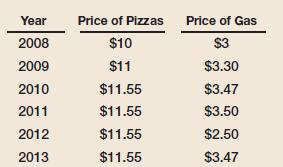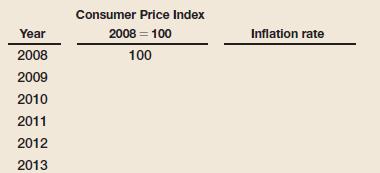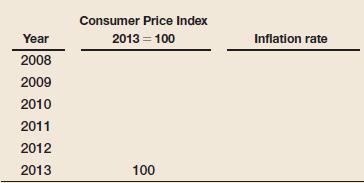The Consumer Price Index represents the average price of goods that households consume. Many thousands of goods
Question:
The Consumer Price Index represents the average price of goods that households consume. Many thousands of goods are included in such an index. Here consumers are represented as buying only food (pizza) and gas as their basket of goods. Here is a representation of the kind of data the Bureau of Economic Analysis collects to construct a consumer price index. In the base year, 2008, both the prices of goods purchased and the quantity of goods purchased are collected. In subsequent years, only prices are collected. Each year, the agency collects the price of that good and constructs an index of prices that represents two exactly equivalent concepts. How much more money does it take to buy the same basket of goods in the current year than in the base year? How much the purchasing power of money has declined, measured in baskets of goods, in the current year, from the base year?
The data: In an average week in 2008, the Bureau of Economic Analysis surveys many consumers and determines that the average consumer purchases 2 pizzas and 6 gallons of gas in a week. The price per pizza and per gallon in subsequent years are found below.
Prices change over time.

a. What is the cost of the consumer price basket in 2008?
b. What is the cost of the consumer price basket in 2009 and in subsequent years?
c. Represent the cost of the consumer price basket as an index number in the year 2008 to 2013. Set the value of the index number equal to 100 in 2008.
d. Calculate the annual rate of inflation using the percent change in the value of the index number between each year from 2009 through 2013.
You would find it helpful to fill in the table below:

e. Is there a year where inflation is negative? Why does this happen?
f. What is the source of inflation in the year 2011? How is that different than inflation in the years 2009 and 2010?
g. I have 100 dollars in 2008. How many baskets of goods can I buy with $100 in 2008? If I have$100 in 2013, how many baskets can I buy with that money in 2013? What is the percentage decline in the purchasing power of my money? How does the percentage decline in the purchasing power of money relate to the change in the value of the price index between 2008 and 2013?
h. From 2009 to 2011, the price of a pizza remains the same.
The price of gas rises. How might consumers respond to such a change? In 2012, the price of gas falls. What are the implications of such changes in relative prices for the construction of the Consumer Price Index?
i. Suppose the Bureau of Economic Analysis determines that in 2013, the average consumer buys 2 pizzas and 7 gallons of gas in a week. Use a spreadsheet to calculate the Consumer Price Index set equal to 100 in 2013 and moving back in time, using the 2013 basket in the years from 2008 to 2013. Fill in the table below:

Why are the inflation rates (slightly) different in part d. and part i
Step by Step Answer:






